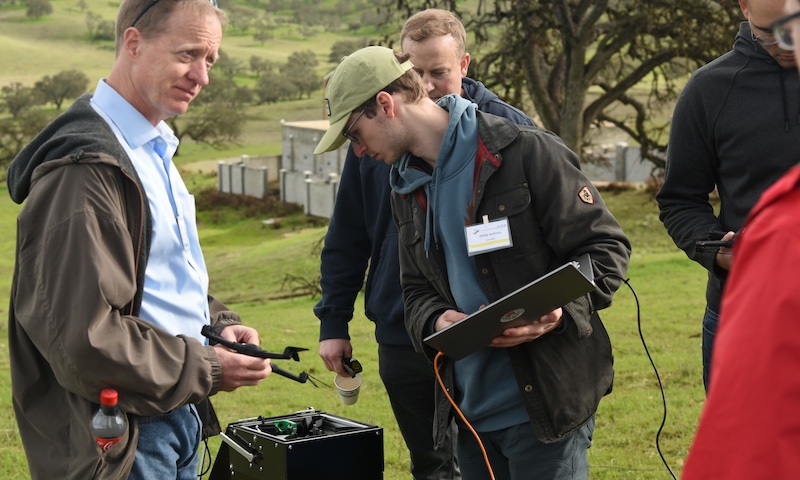Every three months, like a high-tech pilgrimage, dozens of industry technologists journey from across the nation to a backcountry gathering at Camp Roberts, a U.S. Army National Guard base in southern Monterey County, California. They bring cutting-edge equipment of all shapes and sizes, functions and capabilities – and stages of development – for a unique five-day event.
They come for the Naval Postgraduate School’s (NPS) Joint Interagency Field Experimentation (JIFX) program to brainstorm, conduct experiments, and showcase their latest innovations in front of NPS student, faculty, and staff observers, as well as U.S. Navy and Department of Defense (DOD) representatives.
The National Security Strategy and National Defense Strategy both call for increasing defense innovation through greater collaboration across industry, academia and the DOD. But innovation doesn’t just happen within large companies or defense primes – in fact, small businesses offer unique advantages.
The director of JIFX, retired U.S. Army Col. Michael Richardson, is quick to emphasize the importance of a cooperative platform that enables companies without deep pockets or influential connections to participate, and that the ingenuity leading to breakthroughs can come from any direction. JIFX provides this platform.
So, ahead of each day’s activities, Richardson restates the six principles that guide JIFX: “Austere by design; bounded, not controlled; inclusive; ‘develop now’ mantra; collaboration is expected; and failure is acceptable.”
The Office of Innovation and Modernization (I&M), which falls within the Office of the Under Secretary of Defense for Research and Engineering (OUSD (R&E)), sponsors JIFX. I&M accelerates defense innovation through prototyping to rapidly mature and transition capabilities aligned to DOD’s strategic imperatives. In support of OUSD (R&E)’s vision for robust engagement across the innovation ecosystem, I&M explores innovative ideas and technologies from small businesses and startups through discovery venues like JIFX.
“Our charter is to discover innovative technologies that we can mature, rapidly prototype, and then field throughout the services,” said I&M director Jon Lazar, who provided feedback and insight to the technologists while attending the most recent event.
“We're an enabler and an accelerator, moving technology along so that it can become something that's not simply a science experiment. JIFX creates a set of conditions where this kind of purposeful and targeted innovation and prototyping can occur,” Lazar added.
Over the years, development activities at JIFX have helped yield a string of success stories, such as the Shield AI (formerly Martin UAV) V-BAT, a vertical takeoff and landing (VTOL) uncrewed aerial vehicle (UAV) that’s named after the flying mammal. At JIFX in 2016, the tail-sitter drone with a fixed wing and pusher propeller achieved its unassisted vertical takeoff and landing benchmark.
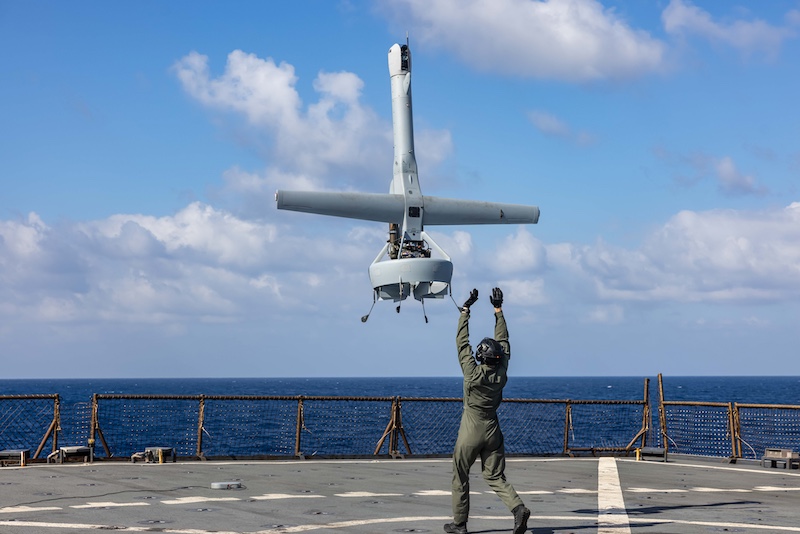
Once airborne, V-BAT tilts downward to fly horizontally like a conventional airplane. In 2018, it broke two milestones at JIFX by flying to an altitude of 15,000 feet and a range exceeding 50 miles. Now in 2024, V-BAT is flying off the decks of U.S. Navy vessels and completing operationally-relevant missions.
“We want an environment where we don't have to do innovation iterations once a year,” Lazar added. “Innovation should be happening constantly. If we're going to accelerate capability development, then we must create an environment where iterations can happen more and more quickly. The series of I&M-funded JIFX events gives us this ability.”
Based on the pressing needs of the Navy and DOD, a new research theme is designated for each quarterly meeting to focus the technologies being showcased. During the most recent JIFX in February 2024, the theme was multi-domain uncrewed systems (UxS) and countermeasures. And for the upcoming meeting in May, it will be C5ISR (command, control, communications, computers, cyber, intelligence, surveillance, and reconnaissance) and countermeasures.
JIFX is deliberately accessible to small companies – even single-person operations – and offers extraordinary opportunities for the participants to push their equipment to the limits, under conditions that are typically out of reach for them, to collect valuable data and insights.
Isolated deep within the borders of Camp Roberts, JIFX affords technologists access to thousands of feet of restricted airspace at and around McMillan Airfield, urban and subterranean structures at the Combined Arms Collective Training Facility (CACTF), miles of surrounding offroad terrain, and a field laboratory to provide a collaboration space for technologies to partner and modify their systems in real-time.
JIFX serves as an incubator for putting ideas and brainpower into action. Participants have the space they need to spread their wings, and in some cases take off. Back during February’s JIFX, on a windy and rainy day, engineers from GreenSight conducted the first flight of the WeatherHive swarming meteorological measurement system with its UAV emerging from its “hive” canister.
“We flew a vertical ascent mission, collected data, and went to about 1,000 meters with our weather drone," said GreenSight senior engineer Eli Davis during the event debrief.
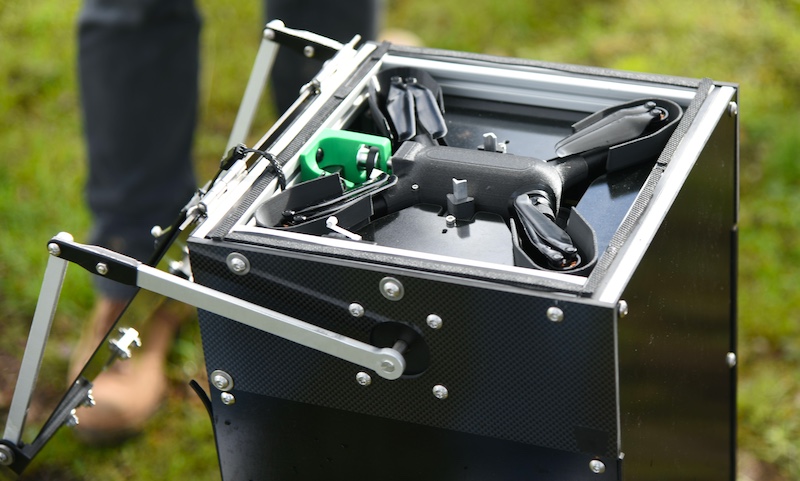
Slightly larger than an outstretched human hand, the quadcopter design appeared at first glance like something a neighbor’s child would fly over the fence. But there’s always more than meets the eye going on with the technology at JIFX. Designed to contain 10 UAVs and to be portable, the “hive” can be deployed to collect immediate weather data at remote locations where local meteorological conditions are unknown. As a result, GreenSight’s technology isn’t just about a single drone; it’s about how a swarm of drones can collectively work together to perform important missions.
Continuing to align with JIFX’s principles, while the GreenSight UAV zipped along collecting weather data, engineers from IoT/AI field tested their C5ISR sensor systems, which are designed to detect UAVs in contested environments. As GreenSight expanded its flight envelope, the IoT/AI team experimented and collected data under real-life tracking situations.
A day later, the star attraction could have been the large eight-rotor UAV operated by Rhoman Aerospace, but it was actually the UAV’s GPS-denied, vision-based navigation system that caught the most attention. The octocopter testbed explored the system’s ability to navigate along a flight route by using landmark features as visual waypoints.
From the ground, Grayscale AI had a different perspective, as its neuromorphic vision camera kept a watchful eye on Rhoman’s test flight. The powerful dynamic range of the Grayscale AI camera’s sensors promises to render a common combat tactic obsolete. For more than a century, pilots have flown from the direction of the sun to mask their presence as they approached their adversaries. Grayscale AI’s sensors have the sensitivity to unveil a drone flying in front of the sun and effectively eliminate this blind spot.
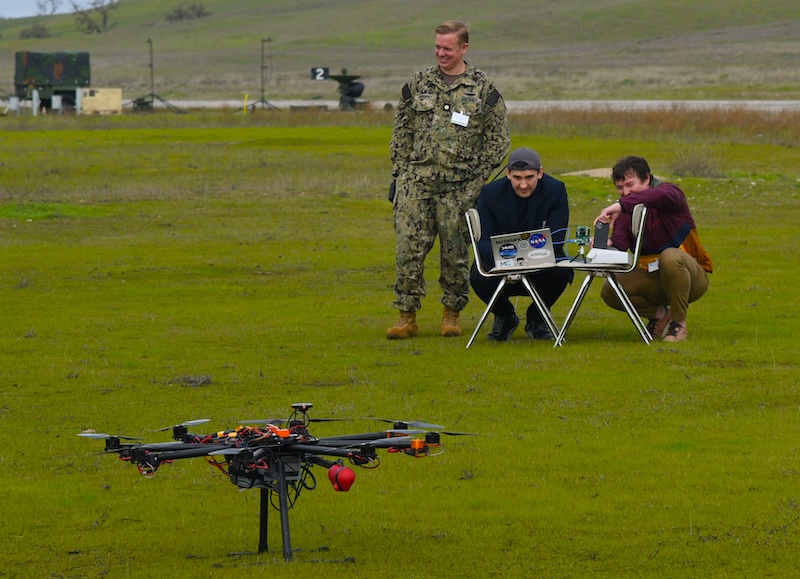
The cooperation at JIFX extends even further than individual industry platforms. In addition to examining the technologies in use and engaging with the engineers and scientists behind them, NPS students, faculty, and staff also participate by conducting their own experiments and sharing their own research activities.
During the JIFX held in October 2023, three NPS students – U.S. Navy Lt. Austin Dumas and Lt. Cmdr. Hans Lauzen, and U.S. Marine Corps Capt. Daniel Lim – experimented with an autonomous surface vehicle (ASV) prototype that was the product of their graduate research and a partnership with Saronic Technologies. Operating from Camp Roberts, their team used resilient space-based communications for over-the-horizon tracking and tasking of the ASV, which was located hundreds of miles away. Within 14 months, the students helped accelerate a promising solution that addressed one of the Navy’s pressing capability gaps.
When NPS student Lt. Joshua Nach, a Navy information professional officer, first attended JIFX, he had a different mission in mind. “I’m trying to see what I can add to future technologies,” said Nach. While looking into ideas for his thesis research, Nach was impressed by the exposure to cutting-edge technology.
“I have a better understanding of the pipeline that goes into developing capabilities we'll see in the fleet,” said Nach. “Getting a sense of what current problems people are looking at, like ad hoc networks and stuff like that, helps give me a direction.”
The interactions that occur during the technology demonstrations provide a two-way street. In one direction, the Navy and other DOD stakeholders get to see and learn about what’s happening on the cusp of emerging technology.
“We don't know what we don't know,” said an attending Naval Special Warfare officer who is responsible for science and technology and technical experimentation. “So, we use JIFX to scout and nominate technologies that are of interest to us and that we would like our guys to see and experiment with. It's a great way to be introduced to and vet new capabilities and technologies.”
Going the other direction, the technologists get immediate feedback and gain information and insight into the current and future needs of national defense. By incorporating this understanding, they can adapt and refine their designs to better align with current and future operational requirements.
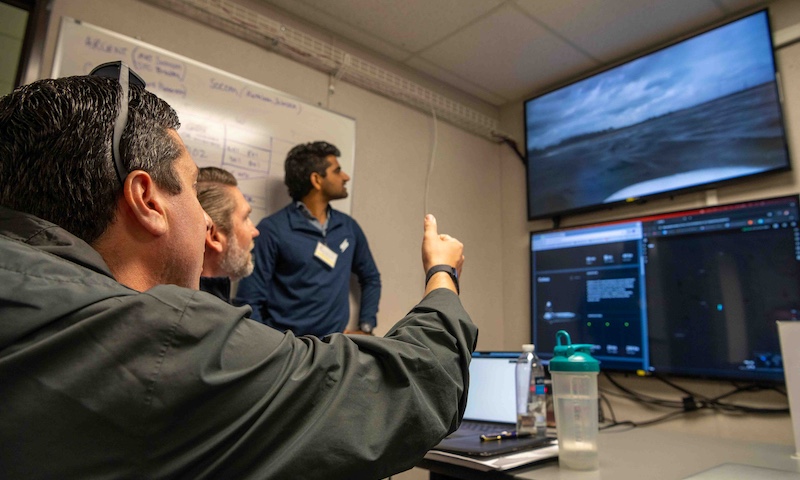
NPS faculty member U.S. Air Force Lt. Col. Jamie Porchia, who specializes in acquisitions research and teaches enterprise innovation and sourcing at NPS, sees exactly how this comes into play.
“As an instructor and a contracting officer, it was great for me to see how JIFX worked to bring technologies together,” Porchia said. “Attending it gave me a unique opportunity to see the collaboration and to be able to interact with users and contractors.”
JIFX allowed Porchia to dive deeper into how technology suppliers and end users can cooperate in the field to stimulate and streamline the development process. “This efficiency can result in deeper market intelligence insights and expedited learning of the capabilities available to support current and future mission requirements,” she said.
As technological innovation continues to advance, and the challenges confronting national defense continue to persist, JIFX ensures these two paths overlap now and into the future. And this gives the Navy and DOD a bigger bang for the buck.
Participation in Joint Interagency Field Experimentation (JIFX) events does not constitute endorsement of participating companies or their products or services by the Naval Postgraduate School, the Department of the Navy, or the Department of Defense.


